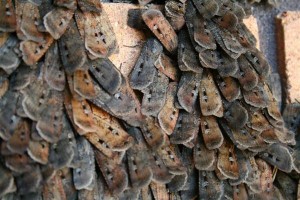The Annual Migration of Bogong Moths
 Every year between September and November, the Bogong moth (Agrotis infusa) migrates to the Bogong High Plains. The Bogong High Plains form part of the Victorian Alps of the Great Dividing Range. They are located in the Alpine National Park in the Australian state of Victoria and are situated south of Mount Bogong.
Every year between September and November, the Bogong moth (Agrotis infusa) migrates to the Bogong High Plains. The Bogong High Plains form part of the Victorian Alps of the Great Dividing Range. They are located in the Alpine National Park in the Australian state of Victoria and are situated south of Mount Bogong.
The moth’s name, Bogong is derived from the Australian Aboriginal Dhudhuroa word Bugung. A town, Bogong, as well as Mount Bogong, have both been named after the moth.
An estimated 4000 moths sweep through the city of Canberra each year as part of their annual migration toward the Bogong High Plains. The moths infiltrate homes, offices, restaurants and the Parliament building. The swarms of moths pouring into Parliament House have clogged the building, setting off fire alarms and requiring special vacuum cleaners to remove them.
Much to the relief of Canberra residents, during the recent 2014 migration, the number of moths reduced to only about 1000. They also only appeared in late November, whereas they are most commonly seen during October. These changes have been researched by an ongoing survey conducted by the NSW Environment and Heritage Council, that tracks the moths’ migration each year.
It is expected that the decline in numbers is largely related to climatic conditions. The severe drought in NSW and Queensland resulted in less moths being bred this year. The weather conditions during the winter breeding months play an important role and directly impacts their spring migration period.
Cutworms are the larvae of the Bogong moth. These worms cause devastation in canola crops throughout New South Wales. These pests sever the stems of emerging seedlings and have the potential to wipe out young whole plantations of crops.
The rain and unseasonably warm autumn weather of 2014 resulted in higher than usual numbers of Bogong larvae. Some farmers reported losing up to 200 hectares of canola because of cutworms. So while Canberra was relieved for the moths’ decreased population due to the dry winter months, the NSW farmers experienced higher than usual losses.
Entrepreneurs have noticed a potential business opportunity of this annual migration. This large brown, furry moth is now being served in Canberra restaurants during the migration season. Restaurant owners have decided to utilise the surplus of moths that clutter the city each year – and residents are quite relieved to have less of these critters fluttering around. The moths are roasted, which reportedly yields a nutty, popcorn flavour, and some chefs have even started creating special Bogong dishes.






